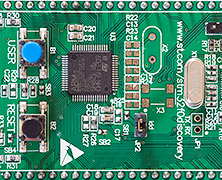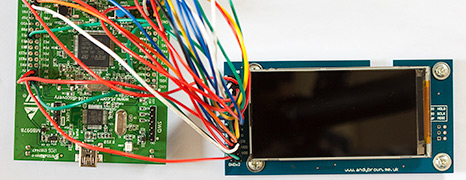A few months ago I made the decision to start supporting the lower priced, hobbyist friendly STM32 devices in my stm32plus C++ library. These lower-end devices come in lower pin-count, smaller packages that are easier to work with and they have reduced clock speeds that make for fewer PCB...
stm32plus 3.1.1: Supporting the STM32 VL Discovery
posted by Andy
If you’ve been following the releases on my stm32plus github repo then you’ll already be aware that version 3.1.1 has been released. The main feature of this new release is support for the STM32 Medium Density Value Line devices, exemplified by the STM32 Value Line Discovery board...
Reverse engineering the Sony Ericsson Vivaz high resolution 640 x 360 cellphone LCD
posted by Andy
Welcome to another in my series of cellphone LCD reverse-engineering articles. In this article I’m going to present everything you need to hook up the high-resolution 640×360 LCD from the Sony Ericsson U5 Vivaz to your project. About the phone and LCD The Sony Ericsson U5 Vivaz LCD...
Reverse engineering the LG KF700 480 x 240 widescreen cellphone LCD
posted by Andy
Hello and welcome to my first published non-Nokia cellphone LCD reverse-engineering effort. All my articles in this series focus on bringing you all of the details that you would need in order to connect a low-cost cellphone LCD to an MCU for use in your own projects. This one is no different. I will explain the pinout and the signals. I will tell you about the connector and where you can buy it and I will tell you about the controller IC and of course I will give away the complete source code driver for that controller. Let’s get started. The LG KF700 The KF700 was released in 2008 and is now a discontinued model. It featured a 3.0...
stm32plus::net, a C++ TCP/IP stack for the STM32
posted by Andy
Welcome to a landmark release, version 3.0.0, of my stm32plus C++ library for the STM32F1 and STM32F4 series of microcontrollers. This release introduces support for the ethernet MAC peripheral in the form of an object-oriented TCP/IP stack as well as support for the STM32F107 connectivity...
A generic optimised 16-bit LCD adaptor for the Arduino
posted by Andy
There are many TFT modules available on the market that are designed to connect directly to an MCU to provide a full colour graphical display, just search ebay for “tft module” to see what I mean. Unfortunately for Arduino users the majority of these modules expose a 16-bit...
Reverse engineering the Nokia E73 QVGA LCD
posted by Andy
Readers with a keen memory will no doubt recall that I said that the N93 would probably be the last of the Nokia QVGA LCDs that I attempt to reverse engineer. However probably is not definitely and one day whilst browsing ebay my finger slipped and next thing I knew I’d got myself an...
Arduino Mega 512K SRAM in shield format
posted by Andy
Some time ago now I presented the design, development board and software driver for an add-on to the Arduino Mega that gave it access to 448Kb of additional SRAM arranged in 8 banks of 56Kb. My design was realised by a compact add-on board that plugged into the relevant block of pins on the...
stm32plus 2.1.0
posted by Andy
The latest release is now 3.0.0. Be sure to check out the announcement here. Due to the use of c++0x features the minimum compiler requirement is now version 4.7.0 of gcc stm32plus version 2.1.0 has now been released and is available from my downloads page. This article will...
Generic Nokia LCD hacking board
posted by Andy
Over the course of the last few months I’ve been presenting schematics and PCBs that you can use to attach various Nokia LCDs to popular microcontrollers. Today I’m going to go one step further and present the generic board that I use for hacking any Nokia LCD that happens to have...
stm32plus 2.0.0: a major release
posted by Andy
The latest release is now 3.0.0. Be sure to check out the announcement here. I’m excited to announce that version 2.0.0 of stm32plus, the C++ library for STM32 devices has been released including lots of new features most significant of which is full support for the...
Reverse engineering the Nokia N93 QVGA LCD
posted by Andy
Welcome to what will probably be the last in the series of articles in which I reverse engineer one of the Nokia QVGA cellphone displays from the pre-smartphone era. I think that by now I’ve covered every possible aspect of these incredibly cost effective little displays and hopefully...
Reverse engineering the Nokia N95 8Gb QVGA LCD
posted by Andy
In this, the latest instalment of my Nokia QVGA TFT reverse engineering series, I will take on the 2.8 inch 24-bit TFT that is designed to work with the Nokia N95 8Gb mobile phone. Read on to see how it worked out. Background In the first of my reverse engineering articles I tackled the Nokia 2730 display. I successfully discovered enough of the command set to write a driver for the Arduino and the STM32. Flush with that success I moved on to tackle the Nokia 6300 and the Nokia N82. I was lucky in that these two shared the same pinout and command set as the 2730 so I could produce a development board with little difficulty. The N95...
An Ethernet PHY for the STM32F107 and STM32F4
posted by Andy
A what? If you’ve never crossed paths with ethernet technologies before then you may not know what an ethernet PHY is. Well, it’s the physical transceiver that converts a well-known data-bus protocol implemented by your MCU into the physical signals that go down the wire. MCU...
Nokia N82 2.4 inch QVGA TFT on the Arduino
posted by Andy
It’s been a few months now since I released the original two articles that detailed the design, build and optimised software library for the 2.0″ Nokia 6300 QVGA TFT connected to the Arduino Mega XMEM interface. Judging by the responses I’ve had, there’s a lot of you...
Interfacing the Nokia 6300 QVGA TFT to the standard Arduino
posted by Andy
In two of my previous articles (here and here) I explained how we could connect the 8-bit 8080 interface presented by the TFT panel to the XMEM interface of the Arduino Mega to achieve a high performance full-colour graphical interface. I went on to present a high-performance open-source...
stm32plus: ILI9327 TFT driver
posted by Andy
The code presented in this article requires a minimum of version 3.0.0 of my stm32plus library. The TFT panel The ILI9327 is a driver IC for 432×240 (WQVGA) panels. The panels are typically found in mobile phones; LG went through a phase of producing lots of phones with...
Nokia QVGA TFT LCD for the Arduino Mega. Design and build (part 1 of 2)
posted by Andy
In two of my previous articles I showed you how to reverse engineer the Nokia 2730 LCD for connecting to a device with 3.3V I/O’s and then I showed you how to build a 16-channel level converter for connecting devices together that have differing I/O level requirements. This article...


















